Bonsai Trees
Case Histories
Japanese Mountain Maple - (acer palmatum)
Maple Bonsai Style: Informal Upright
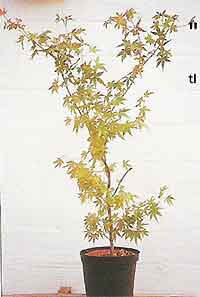
Whilst on holiday one year I noticed a poster advertising a local bonsai exhibition. My interest in this rewarding hobby was just beginning and I only had a handful of trees. Keen to see some 'real' bonsai I attended the show the next day and had the good fortune to meet a knowledgeable enthusiast who befriended me. He showed me around the exhibition and invited me to view his collection the following day. His trees were wonderful and being a complete novice at the time he was keen to encourage my interest.
He very generously gave me several small trees and we have kept in touch ever since. Living only some 50 miles away, he would occasionally visit, always bringing a bonsai related gift. On one such occasional, one of these gifts was a small maple cutting that he had just rooted and it was about 10 cm (4 inches) in height. This was to be the first of many maples I now have in both my bonsai collection and my garden.
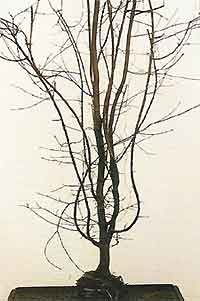
My friend's advice was to let the tree grow for several years so that the trunk would thicken. I did just that and each year potted on into a larger flower pot, feeding well. The maple soon began to grow vigorously and I resisted my strong temptation to plant it in a bonsai pot.
Three years later, after reading an article in a bonsai magazine about the benefits of growing on in the garden I planted this maple in the ground, where it soon reached over 1 1/2 metres high (5 feet). It was a very attractive feature of the garden, but it was getting too large and needed reducing in height. I thought that this maple could now yield some air layerings and so set to work. Being late spring, it was an ideal time to do this and after a couple of hours, ten branches had been carefully layered.
Maple Bonsai History: Training
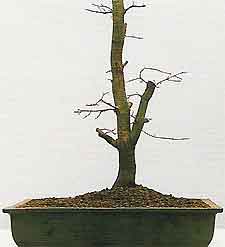
As the weeks passed, two of the smaller branches died, but the rest continued to grow and it was not long before I noticed roots appearing in the moss-filled bags. When many roots became visible I potted all my new maples into separate flower pots. I was glad that I had not just simply pruned off these unwanted branches. Instead I now had the satisfaction of successfully propagating maples using the air layering technique for the first time.
The maple remained in the ground for a further two years. After that period it was lifted in late winter and pruned hard. I decided to utilize a thick side branch that had grown upwards, resembling a second trunk and planted the tree in a rectangular bonsai pot. The surface roots were poor and one large, ugly root was removed, slightly improving the buttress.
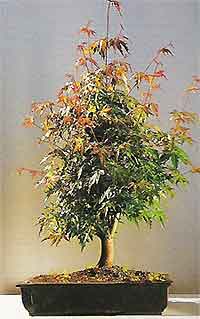
Buds opened all over the tree and the shoots extended. I fed very lightly so that the twigs would not become leggy and clumsy. The next year I leaf pruned for the first time and wired many of the developing branches in an upwards direction. That autumn the leaves turned a stunning fiery red, almost glowing.
After growing in the pot for three years, a more suitable dark blue oval pot was found and being slightly larger and shallower, suited the tree more. When repotting each spring I brushed the small surface roots outwards, radiating from the trunk and by now they were beginning to improve greatly. I exposed many of them and further removed several small branches which were no longer needed.
The maple is root pruned each spring and thinned out extensively, so that when the leaves open the canopy is not dense, but airy and graceful as a maple should be. Most years it is defoliated and is beginning to develop a good winter image. With a fine tracery of small twigs now present, the maple is improving each year.
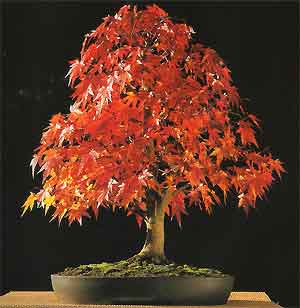
 Whilst on holiday one year I noticed a poster advertising a local bonsai exhibition. My interest in this rewarding hobby was just beginning and I only had a handful of trees. Keen to see some 'real' bonsai I attended the show the next day and had the good fortune to meet a knowledgeable enthusiast who befriended me. He showed me around the exhibition and invited me to view his collection the following day. His trees were wonderful and being a complete novice at the time he was keen to encourage my interest.
Whilst on holiday one year I noticed a poster advertising a local bonsai exhibition. My interest in this rewarding hobby was just beginning and I only had a handful of trees. Keen to see some 'real' bonsai I attended the show the next day and had the good fortune to meet a knowledgeable enthusiast who befriended me. He showed me around the exhibition and invited me to view his collection the following day. His trees were wonderful and being a complete novice at the time he was keen to encourage my interest. My friend's advice was to let the tree grow for several years so that the trunk would thicken. I did just that and each year potted on into a larger flower pot, feeding well. The maple soon began to grow vigorously and I resisted my strong temptation to plant it in a bonsai pot.
My friend's advice was to let the tree grow for several years so that the trunk would thicken. I did just that and each year potted on into a larger flower pot, feeding well. The maple soon began to grow vigorously and I resisted my strong temptation to plant it in a bonsai pot. As the weeks passed, two of the smaller branches died, but the rest continued to grow and it was not long before I noticed roots appearing in the moss-filled bags. When many roots became visible I potted all my new maples into separate flower pots. I was glad that I had not just simply pruned off these unwanted branches. Instead I now had the satisfaction of successfully propagating maples using the air layering technique for the first time.
As the weeks passed, two of the smaller branches died, but the rest continued to grow and it was not long before I noticed roots appearing in the moss-filled bags. When many roots became visible I potted all my new maples into separate flower pots. I was glad that I had not just simply pruned off these unwanted branches. Instead I now had the satisfaction of successfully propagating maples using the air layering technique for the first time. Buds opened all over the tree and the shoots extended. I fed very lightly so that the twigs would not become leggy and clumsy. The next year I leaf pruned for the first time and wired many of the developing branches in an upwards direction. That autumn the leaves turned a stunning fiery red, almost glowing.
Buds opened all over the tree and the shoots extended. I fed very lightly so that the twigs would not become leggy and clumsy. The next year I leaf pruned for the first time and wired many of the developing branches in an upwards direction. That autumn the leaves turned a stunning fiery red, almost glowing.